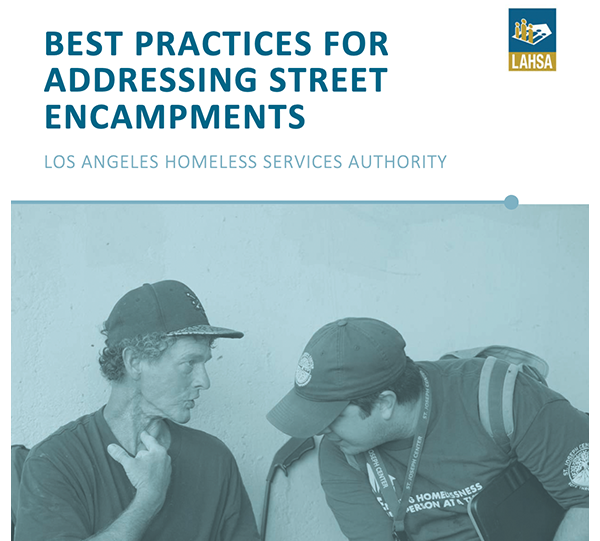The Los Angeles Homeless Services Authority (LAHSA) released its Best Practices for Addressing Street Encampments, which provides guidance for service providers and community partners on the most effective ways to conduct location-specific outreach to bring those living in encampments inside to shelter and housing.
LAHSA consulted with numerous service providers who are subject matter experts on sheltering the unhoused. The Best Practices report offers guidance for balancing the need for location-specific outreach with the importance of a regional, trauma-informed approach to unsheltered homelessness that places people on the path to a stable, permanent home.
“Our system’s 240 outreach teams play a key role in how our system has ended homelessness for more than 65,000 people over the last three years. Outreach teams develop relationships by building trust and confidence with our unsheltered neighbors to place them on a path to housing. Critical to the success of this work is a trauma-informed approach that places the individual’s goals and needs at the forefront. Homelessness is not monolithic, and the solutions, while complex, must be grounded in compassion and equity,” said LAHSA Executive Director Heidi Marston.
The Best Practices are grounded in five key principles, all of which must be addressed to effectively move people from an encampment into housing in a lasting, sustainable way:
- Provide ample time to engage with people living in the encampment during this important transition
- Ensure voluntary, client-centered, and trauma-informed care
- Provide adequate, appropriate, and low-barrier resources
- Identify an experienced service partner with deep ties to the community and let them lead
- Establish strong team coordination
“St. Joseph Center knows from our previous encampment to home projects that the first step in housing a large community of unhoused individuals is recognizing the dignity of the encampment residents. This process can be difficult and it is essential that we build trust and rapport with individuals to get them safely housed,” said Dr. Va Lecia Adams Kellum, President, and CEO, St. Joseph Center. “Our work on Ocean Front Walk will focus on quickly moving individuals indoors and providing them with mental health care, substance use help, and any needed supportive services to keep them stably housed,”
Focusing resources and support on encampments without following the best practices can result in several unintended consequences that push the unsheltered further away from permanent housing, including:
The same people may return to the site of the encampment or disperse into the nearby community within a few days or weeks of receiving shelter;
Taking away critical resources from other vulnerable unhoused people in the region to focus on one encampment does not prioritize regional resources for the most in-need;
Under-planned encampment operations can retraumatize people who have already undergone considerable physical and mental suffering.
LAHSA drew upon several sources to create the Best Practices for Addressing Street Encampments. It started with case studies from El Sereno, Venice and Globe, the Sepulveda Recreation Center, and the Encampment-to-Home program. LAHSA also added insights from the Paxton-Bradly encampment relocation, an Arnold Ventures report on addressing unsheltered homelessness, and the United Way’s Home for Good Street Strategy.
“We have a choice – we can learn and help, or we can repeat and fail. We can put alignment and resources behind the tools and abilities we have to meet the needs of our unhoused neighbors and get people on a path to permanent housing, or we can refuse to learn from the mistakes of the past and use enforcement to scatter and retraumatize people,” said Eric Ares, Manager, Homeless Systems Change at the United Way of Greater Los Angeles.
While Best Practices offers the most effective tactics to address unsheltered homelessness, outreach is only as effective as the resources that the teams can provide the unsheltered. While the Los Angeles region is investing in more housing solutions, it needs over 500,000 more affordable homes to prevent economically disadvantaged Angelenos from falling into homelessness and provide homes for the unhoused.
“Until we have more housing, we need to prioritize strategies addressing unsheltered homelessness that are humane, invest our limited resources wisely, and address the root causes of the homelessness crisis,” continued Marston. “Adhering to this guidance will bring and keep our unhoused neighbors inside longer and in a more caring manner that is more cost-effective for taxpayers.”
https://www.lahsa.org/news?article=842-lahsa-provides-guidance-for-addressing-street-encampments

